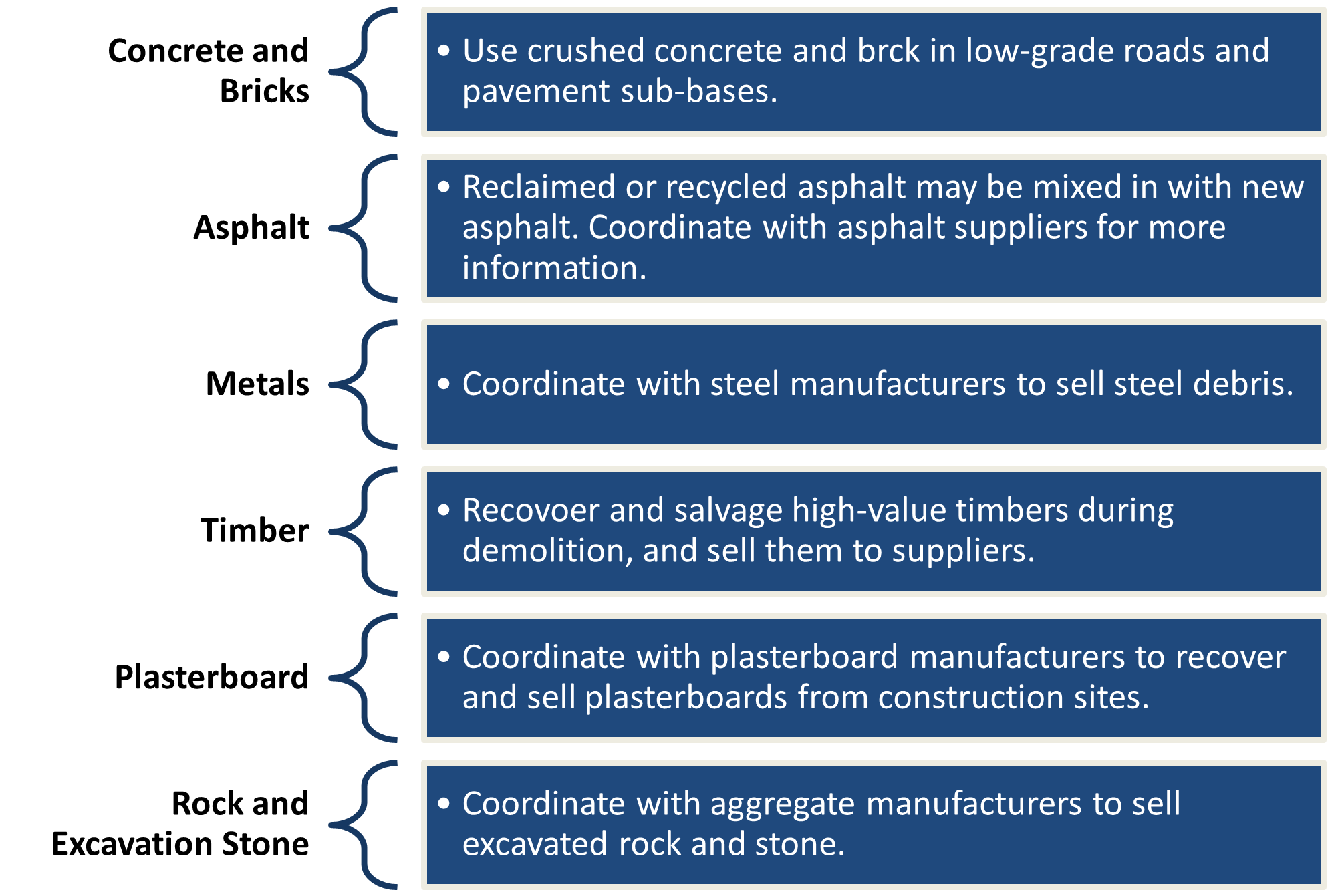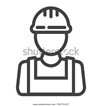The following section will briefly explore demolition specifications for reducing waste reduction and recover materials for reuse to ensure minimisation strategies where the waste management is concerned. Working in construction, demolition and recovery specifications can drastically impact the waste management strategy and are of utmost importance to remaining economical, efficient and compliant.
Demolition is known to generate significant waste in the construction process in various materials such as concrete, asphalt, and metals. Part of your responsibility is adopting demolition practices that increase the recovery of materials for recycling and reuse. Basic practices depending on the type of material, some examples may include:

Some examples of demolition practices have been outlined above. However, practices such as incorporating products developed using steel debris, salvaged timber products, and recovered plasterboards can assist the recycling, reclaiming and reuse of waste incurred from demolition practices. You may also search the Web for relevant case studies that showcase innovative practices in managing demolition waste.
Remember each state and council will have regulation about demolition specifications; additionally, look for similarities between your project and the cases presented in your project's materials and work packages. Then, consult with your construction team to decide how such practices may be adapted in your waste management plan.

When managing the building process to minimise waste, you will be required to determine and use excavation practices to minimise waste and incorporate these waste minimisation strategies. Minimising site excavations and other disposed materials can drastically impact the waste management strategy and are of utmost importance to remaining economical, efficient and compliant.
When determining strategies to minimise the volume of site excavation and other materials disposed of in the landfill, you can compare these with traditional means of waste disposal in Australia. The primary form of disposal is landfill, but this is a somewhat uneconomic practice because of the following reasons:
 |
 |
 |
 |
 |
 |
| High costs of operating and maintaining landfill sites | Limited availability of suitable land | Corrective action being expensive | Health hazards associated with reuse options for landfill sites | The high toxicity of emissions from landfill sites due to concentrations of heavy metals and toxic chemicals | Increasing tip fees |
Strategies that encourage cost competitiveness of recycling options increase and where waste minimisation efforts are rewarded would be a priority for the landfill waste management plans. Some strategies which can be implemented are the following:
- Reducing the life-cycle material use, energy use and waste generation of construction and demolition materials.
- Salvaging, recycling, reusing, and rebuying construction and demolition materials
It is best practice to minimise the amount of waste that your project deposits to landfills. Not only will this help mitigate environmental impact, but you would also avoid unnecessary fines due to waste levies. An example of the materials and what strategies you can adopt to minimise the volume of waste can be seen below.
Materials that you need to reconsider for disposal to landfills include:
- Excavated Soils
- Concrete
- Asphalt
The table below outlines strategies to minimise the volume of site excavation and other materials that are disposed of in landfill.
|
Materials |
Outcome |
Handling procedure |
|
Excavated Soils |
|
Site Stockpile, ensuring wind/water erosion is prevented |
|
Asphalt |
|
Stockpiled, then crushed on- or offsite for fill. Stockpiled, then hauled to the recycling facility |
|
Concrete |
|
Stockpiled, then crushed and removed |
The Australian Government Department of Sustainability, Environment, Water, Population and Communities and the department of transport and Infrastructure has developed a stock-take of waste-related standards, specifications and guidelines. Further examples on excavated soils, asphalt and concrete material usage include:
- Undersealed pavements;
- Shoulder treatments (i.e. the surface treatments located adjacent to road pavements);
- Batter fill;
- Unsealed hard-stand areas associated with road construction;
- Access roads; and
- Footpaths.
Notably, the DPI, Department of Primary Industries state asphaltic and concrete planning shall not be used in locations where more sensitive environmental or health receptors are present or not desirable for aesthetic reasons: landscaping and garden outlines.

Onsite Litter Abatement
Litter derived from the construction site can come from the building process itself and the personnel working on the site. Litter can be harmful to the working environment and lead to contamination of soils, animal endangerment, and floral destruction. Therefore, the waste management strategy must incorporate an appropriate litter abatement strategy.
When adding onsite litter abatement to the waste management strategy, you must first identify practices you can implement on a building and construction site to minimise the amount of litter. You must also briefly explain how each practice works to minimise litter.
For example:
- Litter abatement practice: Using trash bins with covers
- A brief explanation of how this minimises litter: The covers prevent the litter from falling out of the trash bin and scattering into the surroundings.
A simple table can be incorporated into the waste management strategy to list the specified litter abatement strategy and then provide a brief explanation of how this practice will minimise litter. An example has been provided below:
|
Litter abatement practice |
Explanation of how this minimises litter |
|
Using trash bins with covers |
The covers prevent the litter from falling out of the trash bin and scattering into the surroundings. |
|
Having appropriate amounts of bins for recycling, chemical, green and general waste. |
This decreases the likelihood of waste not being separated appropriately into the specified groups. |
Litter is any form of construction waste that has not been appropriately discarded and includes concrete, glass, and wood. Litter contributes to long-term air, soil, and water pollution if not abated properly. It also poses a threat to the construction site's safety as they may obstruct pathways or contribute to fire incidents. As a site manager, it is your responsibility to adopt appropriate litter abatement strategies.
In particular, there are two more areas of onsite construction that you should focus on when addressing litter, namely:
 |
 |
|
Waste processing logistics Some examples of waste processing logistics include ensuring that the garbage skips are prepared and organised correctly. You should protect all waste from contamination, rain and wind as much as possible. This also means that you should lock special skips at night and weekends to prevent others from dumping garbage in them. After safeguarding your skips, you should colour code and label them depending on their usage. Food scraps and household waste generated during construction should have their separate colour-coded bins. It is also ideal that you separate waste for recycling wherever possible, and require all trades to sort waste streams accordingly. For easy recycling, form a compound to contain plastic film, cardboard, glue and paint tins. Where waste segregation is not possible, you should engage a credible waste disposal contractor who will handle mixed waste bins, sort it on their site, and document disposal procedures. With this, you should plan locations where materials will be deposited and stacked before delivery. |
Subcontractor responsibilities When procuring subcontractors, you should ensure that they have strategies for mitigating environmental impacts in their bid proposals. To follow through in their strategies, make sure that your terms of engagement incorporate clauses requiring waste minimisation practice. This includes requiring trades to dispose of their waste and back charging for segregating waste streams not segregated by each subcontractor. In turn, you should enlist your crew for general site clean up regularly. These terms set an example for your trades and mitigate the potential for wind-blown litter and safety issues on site. |
The table is to be incorporated into the waste management strategy listing the specified litter abatement strategy. The table will also provide a brief explanation of how this practice will minimise litter while, including waste processing logistics and subcontractor requirements. Examples have been provided below:
Waste Processing Logistics
|
Litter abatement practice |
Explanation of how this minimises litter |
|
Ensure that the garbage skips are prepared and organised properly |
This assists in the proper allocation of recyclable, chemical, green and general waste. |
|
Protect all waste from contamination, rain and wind |
This reduces the chance of land being contaminated or blown out into the environment. |
|
Lock special skips at night and weekends |
This prevents others from dumping garbage in them |
Subcontractor Responsibilities
|
Litter abatement practice |
Explanation of how this minimises litter |
|
Make sure that they have strategies for mitigating environmental impacts in their bid proposals |
This reduces the incidence of poor waste management on the construction site. |
|
Make sure that your terms of engagement incorporate clauses requiring waste minimisation practice |
This will ensure compliance with waste management strategies and regulations are met. |
|
Requiring trades to dispose of their waste |
This will reduce the incidence of site waste and litter from your own company and encourage trades to reduce waste. |
Every chance must be provided for litter abatement practices to be fulfilled. Unfortunately, if practices are not communicated clearly and concisely, messages can become mixed or ignored, and the abatement or removal of litter can become neglected. A lack of communication may impact not only the waste management strategy but the worksite and the greater environment itself.

Minimising adverse environmental impacts and promoting sustainability by workplace procedures and workplace safety requirements
Unavoidable waste products have the potential to harm. Builders are required to carry out work health and safety procedures to protect all their workers and site visitors; this is the case for waste management. In general, builders should have a specific team take on managing work health and safety. However, the duty to take reasonable care for themselves and others' health and safety applies to everyone in the workplace. Every person in the construction site must be responsible for ensuring workplace safety.
The builder can remain economical, efficient, and compliant if it implements strategies to ensure safe and environmentally effective disposal of unavoidable waste, which also drastically impact the waste management strategy. Moreover, when investigating federal safe work legislation, you can see the WHS Codes of Practice cover building safety concerns of environmental risks such as:
- Asbestos in the workplace,
- Hazardous chemicals
- Abrasive blasting
- Spray painting and powder coating,
- Hazardous manual tasks,
- The safe design of environmentally friendly structures,
- electrical risks,
- demolition works,
- excavation work,
- plant and construction work and many others.
The federal Safe Work website also provides links to state and territory laws which they enforce and regulate. Further to creating policies regarding safe practices in the workplace, employers and contractors will invariably find themselves completing relevant applications for permits, including but not limited to:
- Onsite emergencies
- WHS training and supervision
- Engaging subcontractors with environmentally sound practices
- WHS consultation and participation
- Risk Management
- Hazard identification
- Risk analysis assessment
- Risk control (following Hierarchy of Control)
- Wearing of mandatory PPE
- Machinery-based permits
- Working from heights
- Fall arrest systems and noise reduction.
When learning more about WHS and Safe Work legislation, it becomes apparent how integral this small building business aspect is. There is much to consider generally for WHS; however, WHS practises will align with minimising adverse environmental impacts and promoting sustainability for the waste management strategy.
Workplace safety requirements
To undertake construction work, a person must have completed an introductory safety training course entitled ‘general construction induction training’. This is also commonly referred to as ‘white card’ training.
In keeping with the model WHS Act, you should make sure that every tradesperson has completed white card training. Upon training completion, the successful trainee may apply to a WHS regulator for a white card. White cards issued in one state or territory are generally considered for Australia's whole.
Besides a white card, tradespersons performing high-risk construction work may require specialised licenses. The building manager or owner will need to ensure specialised licences have been granted before work commences.
Workplace procedures
Generally, relevant procedures for the safe disposal of waste will involve:
- Training workers and personnel about disposal procedures.
- Distinguishing between licenced and unlicensed waste removal work.
- Specifying controls applicable to the removal of high-risk waste.
- Using enclosures for larger-scale waste removal.
- Applying appropriate methods for small scall waste removal.
- Applying further controls for waste removal, for example, contaminated soils.
An environmental risk assessment for a project integrating products and materials taking the shape of a general hazard risk assessment was discussed in the previous chapter. This assessment can be now extended to include safe working protocols in waste management practices generally.
Using the environmental risks from the previous assessment, you should align these with WHS safety processes. The above-mentioned environmental risk analysis provided an insight into environmental and safety risk in waste management on the building site. Some of these considerations included proper waste disposal. This includes making sure that any harmful waste does not leak into the environment. In some instances where the creation of waste by-products is unavoidable, these measures are even more necessary. Also, ensure that adequate PPE and safety processes are followed in the disposal of waste by-products to avoid contamination of the environment, worksite and personnel working on the construction.
By using recycled materials, the supplier lessens the demand for raw materials and also lessens the amount of waste in the environment. This reduction results in fewer resources consumed. Personal safety procedures would factor the risk of contamination from leftover residues, moulds, and rust is a matter for consideration. Therefore, appropriate PPE equipment, handling and transportation methods must reduce the risk of harm for those handling the materials.

